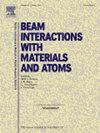Impact of UC2, UC, UBC and UB2 target compositions on the release of fission products
IF 1.4
3区 物理与天体物理
Q3 INSTRUMENTS & INSTRUMENTATION
Nuclear Instruments & Methods in Physics Research Section B-beam Interactions With Materials and Atoms
Pub Date : 2025-02-01
DOI:10.1016/j.nimb.2024.165600
引用次数: 0
Abstract
The release properties of 4 targets (UC2, UC, UBC, UB2) were measured for 11 elements (Kr, Sr, Ru, Sn, Sb, Te, I, Cs, Ba, La, and Ce) using an off-line technique. The crystal packing fraction and the size of the studied element play a key role in the release process. However, physicochemical properties are also involved, notably melting and boiling points in vacuum and the minimal oxidation state. Principal component analysis was used to investigate the interrelationships between the physicochemical properties of fission products (from Fe to Dy) and the observed releases, thereby enabling predictions to be made about the release properties of the four crystallic configurations for elements that are inaccessible in off-line experiments.
UC2、UC、UBC和UB2靶成分对裂变产物释放的影响
采用离线技术测定了4个靶(UC2、UC、UBC、UB2)对11种元素(Kr、Sr、Ru、Sn、Sb、Te、I、Cs、Ba、La和Ce)的释放特性。晶体填充分数和所研究元素的尺寸对释放过程起关键作用。然而,物理化学性质也涉及,特别是熔点和沸点在真空和最小氧化态。主成分分析用于研究裂变产物(从Fe到Dy)的物理化学性质与观察到的释放之间的相互关系,从而能够对离线实验中无法获得的元素的四种晶体构型的释放特性进行预测。
本文章由计算机程序翻译,如有差异,请以英文原文为准。
求助全文
约1分钟内获得全文
求助全文
来源期刊
CiteScore
2.80
自引率
7.70%
发文量
231
审稿时长
1.9 months
期刊介绍:
Section B of Nuclear Instruments and Methods in Physics Research covers all aspects of the interaction of energetic beams with atoms, molecules and aggregate forms of matter. This includes ion beam analysis and ion beam modification of materials as well as basic data of importance for these studies. Topics of general interest include: atomic collisions in solids, particle channelling, all aspects of collision cascades, the modification of materials by energetic beams, ion implantation, irradiation - induced changes in materials, the physics and chemistry of beam interactions and the analysis of materials by all forms of energetic radiation. Modification by ion, laser and electron beams for the study of electronic materials, metals, ceramics, insulators, polymers and other important and new materials systems are included. Related studies, such as the application of ion beam analysis to biological, archaeological and geological samples as well as applications to solve problems in planetary science are also welcome. Energetic beams of interest include atomic and molecular ions, neutrons, positrons and muons, plasmas directed at surfaces, electron and photon beams, including laser treated surfaces and studies of solids by photon radiation from rotating anodes, synchrotrons, etc. In addition, the interaction between various forms of radiation and radiation-induced deposition processes are relevant.

 求助内容:
求助内容: 应助结果提醒方式:
应助结果提醒方式:


